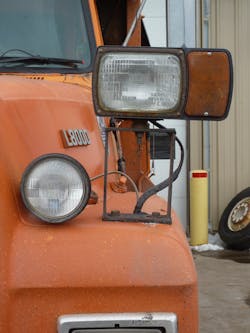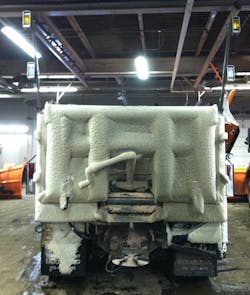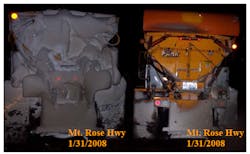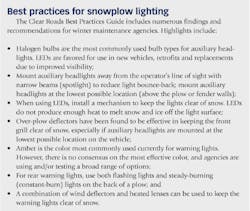Can you see me now?
Snowplow vehicles often perform in conditions of limited visibility, including darkness, fog, and falling or blowing snow.
The primary purpose of equipping snowplows with lighting is to make the roadway more visible for the operators, so they can complete their work safely. However, lighting also serves another important purpose, which is to make snowplows visible to other vehicles on the road. This is a critical safety measure because snowplow vehicles often travel at slower speeds while clearing the roads, which can be potentially hazardous to other motorists who get too close.
Despite the recent development of various lighting technologies, a large number of crashes are still attributed to poor visibility of winter maintenance vehicles. For instance, the Ohio Department of Transportation (ODOT) reported 63 crashes statewide involving snowplows in just one month of the 2010 winter season, compared to 57 crashes during the entire previous winter (2009). Kent County, Mich., reports an average of six rear-end snowplow-related crashes every year.
Winter maintenance agencies can select various types of headlights and work lights with which to equip their snowplows. In addition, they can use supplemental warning lights of different configurations and placement, including on the sides of the vehicles, to help other motorists see and recognize snowplows. However, many transportation agencies struggle with trying to find the right balance of equipment and the best practices for optimal use. For example, it is critical to make snowplows as visible as possible to other drivers, but not so bright that it causes excessive glare or even temporary blindness.
The Clear Roads research program sponsored a recent study to identify current best practices for the use of snowplow lighting options in order to help agencies make decisions such as selecting appropriate lighting packages and mounting lights in the best location. This article summarizes some of the key findings related to auxiliary headlights, warning lights, steady burn vs. flashing lights, and how to keep lights clean of snow.
Figure 1. Proposed mounting location for flashing and steady burning lights.
More light means better plowing
Auxiliary headlights are typically used on the front of snowplow vehicles and provide supplemental illumination of the road surface during plowing. Incandescent bulbs have been used for headlamps since the advent of the automobile more than a century ago. However, over the last two decades, automobiles and trucks increasingly use halogen, high-intensity discharge (HID) and light-emitting diode (LED) bulbs as light sources. In particular, LEDs are becoming more common in newer vehicles. The light produced by LED bulbs is closer to that of daylight; in addition, the bulbs are very energy-efficient and have a long service life. While HID bulbs are comparable to LEDs as a light source, they are not energy-efficient and have a shorter service life. Based on the results of a survey of winter maintenance agencies and snowplow operators, HIDs are still more widely used by agencies than LEDs; however, agencies appear to be testing LEDs in new trucks, replacements and retrofits.
One of the notable disadvantages of LED auxiliary headlights is that they do not produce a lot of heat, unlike HID and halogen bulbs, resulting in snow and ice accumulation on the lights during snow events. Prevention techniques to assuage such occurrences include using a heated lens, installing heated wire mesh over the lens and spraying the lens with cooking spray. Some of these options are more effective than others. Interestingly, the use of the heated lens was found to create a dome of ice over the lens in very cold and snowy conditions. To prevent this, agencies can install a control switch inside the truck that can turn the heated lens on and off based on the type of snow event they are facing.
Auxiliary headlights can cause light bounce-back and light scatter during adverse weather conditions, which is a safety issue for snowplow drivers. The mounting position and beam width of headlights play a significant role in reducing or minimizing this effect. In the research survey, snowplow operators from the New York State Department of Transportation (NYSDOT) reported that the most effective solution to reduce back-scattered light is to place the auxiliary headlights away from the operator’s line of sight. In fact, previous studies suggest installing a passenger-side auxiliary headlight and providing a switch so the operator can turn on the lights during inclement weather conditions only. In addition, snowplow operators preferred using a narrow-beam light source (like a spot lamp) over a wide-beam light source (like a flood lamp) to reduce the amount of back-scattered light.
Recent studies have shown that the color of the light does not play a significant role in reducing back-scattered light. In fact, yellow headlights that were commonly used until the 1990s do not seem to help reduce the glare. A significant number of snowplow operators surveyed for this study suggested using yellow fog lights to reduce the light bounce-back from snow. While this is consistent with older standards, it conflicts with recent research findings.
Visibility for snowplow operators also can be reduced due to light bounce-back from blowing snow during plowing operations. Customized over-plow deflectors, with a trap angle less than 50°, help to prevent snow from blowing over the plow onto the windshield. Interestingly, very few snowplow operators said they have over-plow deflectors on their vehicles. Other methods to keep snow from blowing onto windshields include air foils, bug shields and poly plows (due to a more slippery surface).
Rear warning lights mounted on the telespar showing no snow accumulation.
Warning lights
Warning lights typically provide increased visibility of the snowplow vehicle for other drivers on the road; typically the lights help by indicating the position of the snowplow and its direction of travel. Most agencies prefer using LED-based light systems due to benefits such as increased reliability, increased visibility, increased conspicuity, improved efficiency and reduced maintenance costs. LEDs are commonly used for forward, rear and side warning-light systems.
The color of the light appears to play an important role in ease of visibility for the driving public, but at this time there is no consensus on which color is most effective. For example, DOT respondents indicated that amber- and blue-colored warning lights are widely used in all conditions. However, snowplow operators preferred white and amber-colored warning lights during low visibility (e.g., fog, snow) conditions. The North Dakota Department of Transportation (NDDOT) believes that white warning lights provide the most intense light to penetrate during low-visibility conditions. The Iowa Department of Transportation (IDOT) is testing flashing blue and white LED lights on 175 snowplow vehicles, with the goal of decreasing the number of accidents. ODOT is using green flashing LED lights on snowplow vehicles, and NDDOT also is testing steady-burning, green warning lights. In some locations, the choice of color may be dictated by state or local statutes, which should be checked prior to testing any new colors. Another reason for changing the color of warning lights is to differentiate DOT trucks and plows from other vehicles, such as oil trucks and construction trucks.
Example of an airfoil employed on a winter maintenance vehicle by the Nevada DOT.
Burn vs. flash
Previous studies have suggested that both flashing lights and steady-burn (constant-burn) warning lights play a key safety role for other drivers on the road. Flashing lights help drivers detect the presence of a snowplow (catch their attention), while steady-burn lights help them to detect the relative speed of the snowplow (perceived approach). Figure 1 provides an example of mounting locations for both steady-burn and flashing lights, taking into consideration the vehicle driver’s line of sight. The proposed mounting locations assume that at a longer viewing distance, the driver will have a full view of the back of the snowplow and can see both the high-mounted flashing lights (blue and amber) and the lower-mounted constant-burn (amber) lights (Figure 1a). The flashing lights on the top of the truck bed will help drivers of other vehicles identify the snowplow from a farther distance. At the shorter viewing distance, drivers will have a limited view of the back of the snowplow, and can only see the constant-burn light, but it will help them to gauge the relative speed of the snowplow as they approach from the rear (Figure 1b).
Keeping clear
During snowplow operations, warning lights and work lights can become covered with a layer of snow and ice, making them no longer visible, which presents a major safety issue. This is especially true for LEDs, which due to their increasing popularity among winter maintenance agencies further increases safety concerns. As previously mentioned, LEDs do not produce enough heat to melt snow and ice off the surface of the lights. Research conducted for the Minnesota Department of Transportation (MnDOT) found that air foils are effective in keeping the rear of vehicles clear of snow and that they eliminated the time required by operators to clean off the snow. IDOT recommends installing air blasters (controlled by operators to clear snow from the lights) on trucks operating on interstates and four-lane roadways.
Another option previously mentioned the use of a heated lens to keep the lights clear of snow. The Nevada Department of Transportation (NVDOT) suggested the feasibility of thin sheet heaters powered by a 12-volt source to be used on snowplow lights. NDDOT also mentioned using heated lenses on some of its trucks. However, as previously asserted, it is important that operators have a control switch that can turn the heated lens on and off based on conditions. During warm snow events (around 25°F or warmer), snow generally sticks on the lights and the heated lens helps to melt the accumulated snow on the lens. However, in cold snow events (around 15°F) snow will likely not stick on light lenses. In fact, in such cases, using heated lenses can actually create a dome of ice over the LED lens. At this time, heated lenses with and without control switches are not commonly used.
It also is possible to keep lights clear of snow by altering the mounting locations to increase air flow around the lights. NDDOT suggests using telespar-mounted warning lights elevated above the back of the vehicle. One important consideration is that operators must be careful during loading and unloading operations to avoid damaging the elevated lights.
The Clear Roads research team for this project, led by the Western Transportation Institute at Montana State University, has compiled these findings into a best practices guide for winter maintenance agencies. The guide and the project final report are available on the Clear Roads website (www.clearroads.org).




